Healthcare Finance & Reimbursement: A Financial Principles Draft
VerifiedAdded on 2023/06/03
|11
|2724
|208
Project
AI Summary
This project provides an analysis of financial principles and reimbursement within the healthcare sector. It explores various elements of health insurance plans and the impact of financial management principles on these plans, focusing on provider networks, drug formularies, premiums, plan benefits, and deductibles. The project also discusses reimbursement strategies such as pay-for-performance and value-based purchasing, comparing the advantages and disadvantages of reimbursement methods like fee-for-service and capitation. Furthermore, it evaluates financial management principles including financial data, types of reporting, and revenue cycles, emphasizing their role in assessing the cost and quality of healthcare services. The importance of receivable accounts, teamwork principles, and strategies for reimbursement maximization are also highlighted, with a focus on strategic planning, data utilization, and optimal use of medical specialists to achieve financial stability and improve healthcare outcomes.
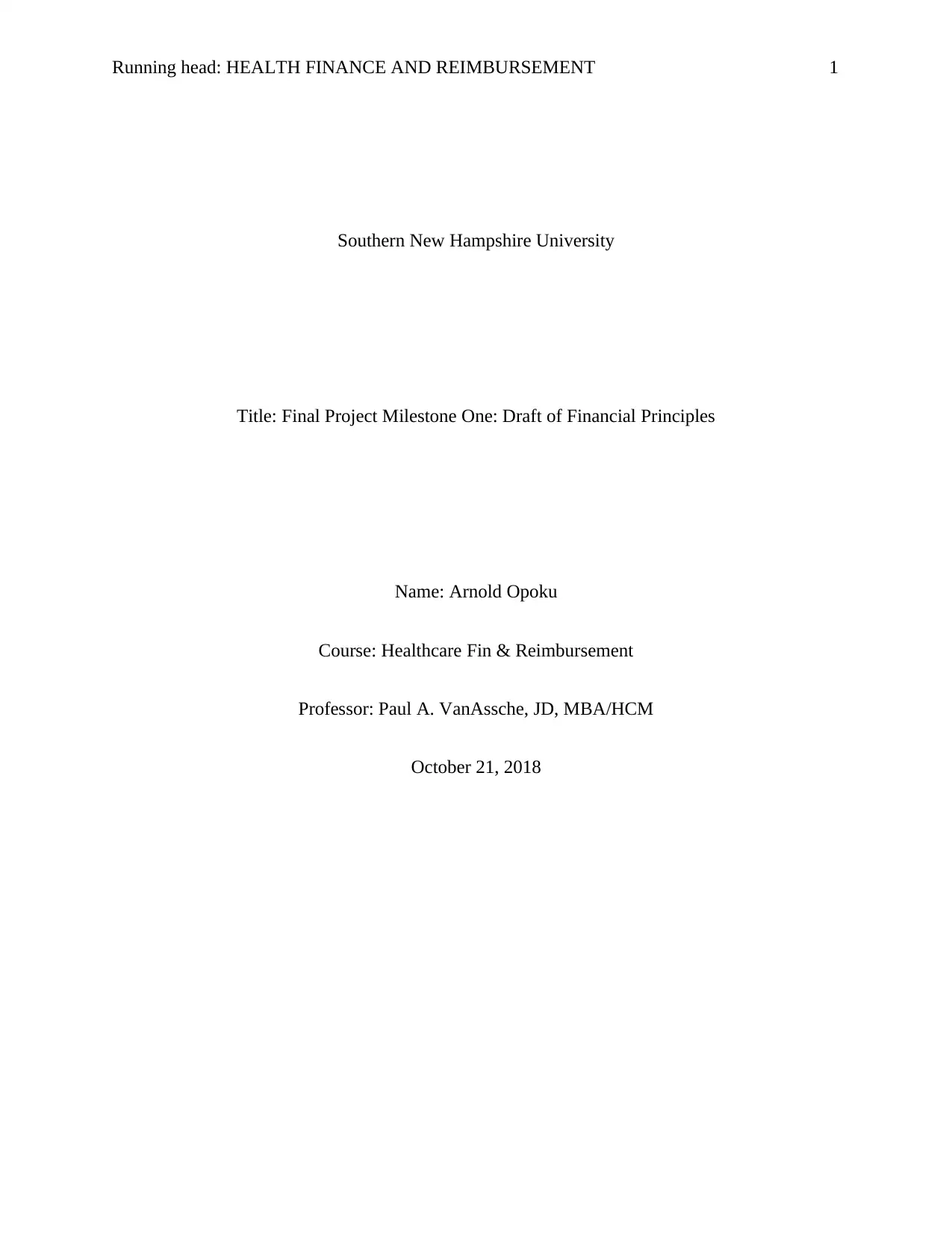
Running head: HEALTH FINANCE AND REIMBURSEMENT 1
Southern New Hampshire University
Title: Final Project Milestone One: Draft of Financial Principles
Name: Arnold Opoku
Course: Healthcare Fin & Reimbursement
Professor: Paul A. VanAssche, JD, MBA/HCM
October 21, 2018
Southern New Hampshire University
Title: Final Project Milestone One: Draft of Financial Principles
Name: Arnold Opoku
Course: Healthcare Fin & Reimbursement
Professor: Paul A. VanAssche, JD, MBA/HCM
October 21, 2018
Paraphrase This Document
Need a fresh take? Get an instant paraphrase of this document with our AI Paraphraser
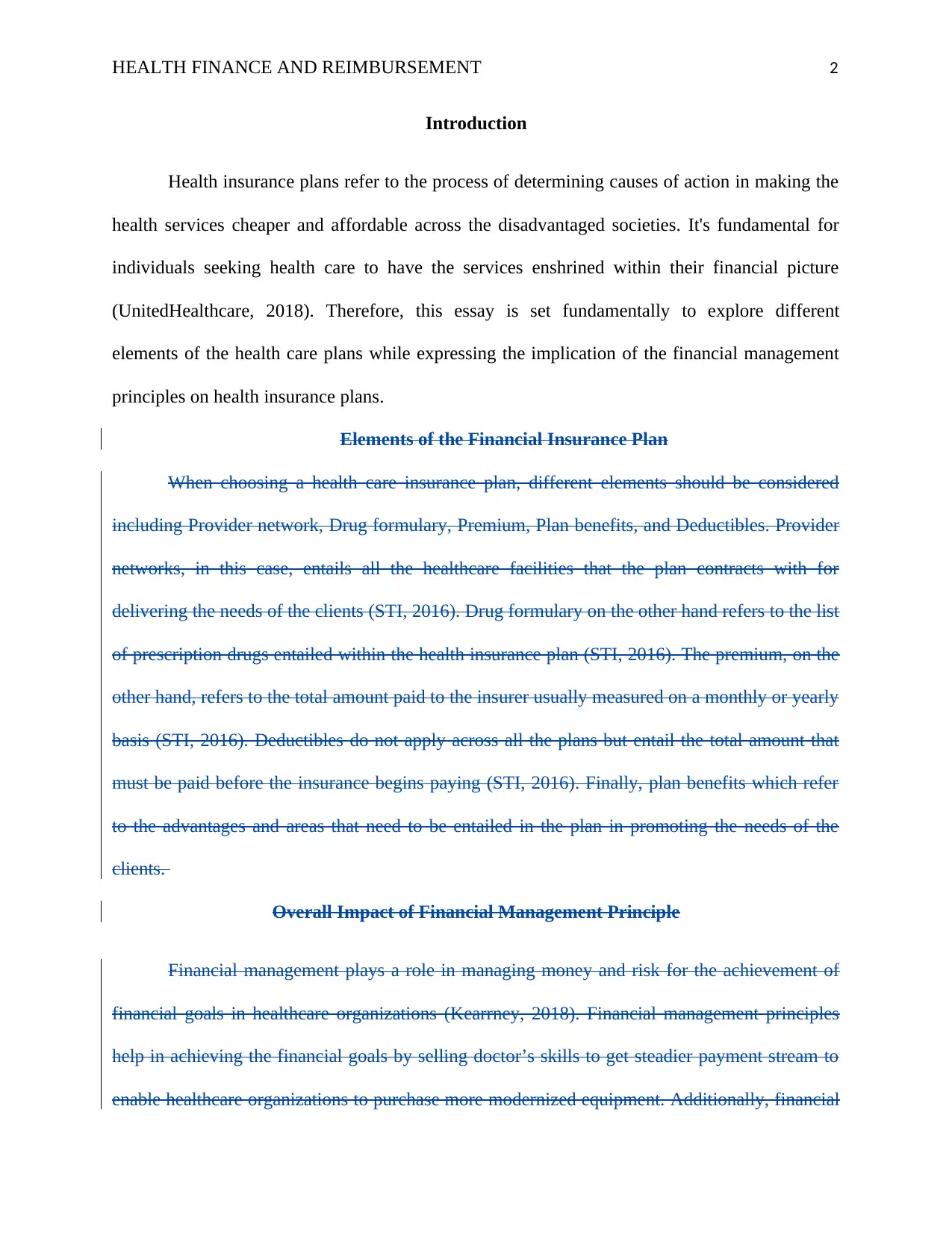
HEALTH FINANCE AND REIMBURSEMENT 2
Introduction
Health insurance plans refer to the process of determining causes of action in making the
health services cheaper and affordable across the disadvantaged societies. It's fundamental for
individuals seeking health care to have the services enshrined within their financial picture
(UnitedHealthcare, 2018). Therefore, this essay is set fundamentally to explore different
elements of the health care plans while expressing the implication of the financial management
principles on health insurance plans.
Elements of the Financial Insurance Plan
When choosing a health care insurance plan, different elements should be considered
including Provider network, Drug formulary, Premium, Plan benefits, and Deductibles. Provider
networks, in this case, entails all the healthcare facilities that the plan contracts with for
delivering the needs of the clients (STI, 2016). Drug formulary on the other hand refers to the list
of prescription drugs entailed within the health insurance plan (STI, 2016). The premium, on the
other hand, refers to the total amount paid to the insurer usually measured on a monthly or yearly
basis (STI, 2016). Deductibles do not apply across all the plans but entail the total amount that
must be paid before the insurance begins paying (STI, 2016). Finally, plan benefits which refer
to the advantages and areas that need to be entailed in the plan in promoting the needs of the
clients.
Overall Impact of Financial Management Principle
Financial management plays a role in managing money and risk for the achievement of
financial goals in healthcare organizations (Kearrney, 2018). Financial management principles
help in achieving the financial goals by selling doctor’s skills to get steadier payment stream to
enable healthcare organizations to purchase more modernized equipment. Additionally, financial
Introduction
Health insurance plans refer to the process of determining causes of action in making the
health services cheaper and affordable across the disadvantaged societies. It's fundamental for
individuals seeking health care to have the services enshrined within their financial picture
(UnitedHealthcare, 2018). Therefore, this essay is set fundamentally to explore different
elements of the health care plans while expressing the implication of the financial management
principles on health insurance plans.
Elements of the Financial Insurance Plan
When choosing a health care insurance plan, different elements should be considered
including Provider network, Drug formulary, Premium, Plan benefits, and Deductibles. Provider
networks, in this case, entails all the healthcare facilities that the plan contracts with for
delivering the needs of the clients (STI, 2016). Drug formulary on the other hand refers to the list
of prescription drugs entailed within the health insurance plan (STI, 2016). The premium, on the
other hand, refers to the total amount paid to the insurer usually measured on a monthly or yearly
basis (STI, 2016). Deductibles do not apply across all the plans but entail the total amount that
must be paid before the insurance begins paying (STI, 2016). Finally, plan benefits which refer
to the advantages and areas that need to be entailed in the plan in promoting the needs of the
clients.
Overall Impact of Financial Management Principle
Financial management plays a role in managing money and risk for the achievement of
financial goals in healthcare organizations (Kearrney, 2018). Financial management principles
help in achieving the financial goals by selling doctor’s skills to get steadier payment stream to
enable healthcare organizations to purchase more modernized equipment. Additionally, financial
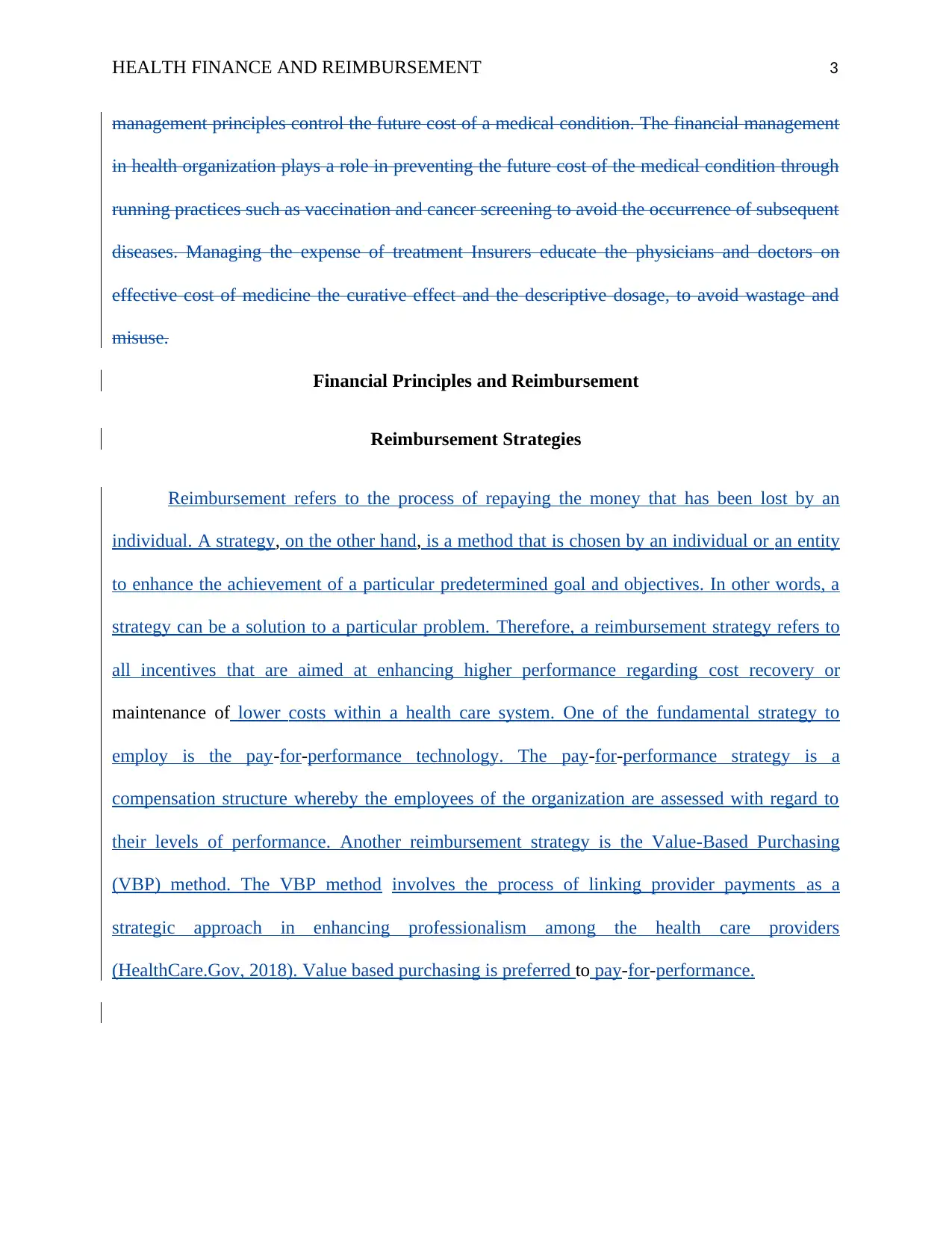
HEALTH FINANCE AND REIMBURSEMENT 3
management principles control the future cost of a medical condition. The financial management
in health organization plays a role in preventing the future cost of the medical condition through
running practices such as vaccination and cancer screening to avoid the occurrence of subsequent
diseases. Managing the expense of treatment Insurers educate the physicians and doctors on
effective cost of medicine the curative effect and the descriptive dosage, to avoid wastage and
misuse.
Financial Principles and Reimbursement
Reimbursement Strategies
Reimbursement refers to the process of repaying the money that has been lost by an
individual. A strategy, on the other hand, is a method that is chosen by an individual or an entity
to enhance the achievement of a particular predetermined goal and objectives. In other words, a
strategy can be a solution to a particular problem. Therefore, a reimbursement strategy refers to
all incentives that are aimed at enhancing higher performance regarding cost recovery or
maintenance of lower costs within a health care system. One of the fundamental strategy to
employ is the pay-for-performance technology. The pay-for-performance strategy is a
compensation structure whereby the employees of the organization are assessed with regard to
their levels of performance. Another reimbursement strategy is the Value-Based Purchasing
(VBP) method. The VBP method involves the process of linking provider payments as a
strategic approach in enhancing professionalism among the health care providers
(HealthCare.Gov, 2018). Value based purchasing is preferred to pay-for-performance.
management principles control the future cost of a medical condition. The financial management
in health organization plays a role in preventing the future cost of the medical condition through
running practices such as vaccination and cancer screening to avoid the occurrence of subsequent
diseases. Managing the expense of treatment Insurers educate the physicians and doctors on
effective cost of medicine the curative effect and the descriptive dosage, to avoid wastage and
misuse.
Financial Principles and Reimbursement
Reimbursement Strategies
Reimbursement refers to the process of repaying the money that has been lost by an
individual. A strategy, on the other hand, is a method that is chosen by an individual or an entity
to enhance the achievement of a particular predetermined goal and objectives. In other words, a
strategy can be a solution to a particular problem. Therefore, a reimbursement strategy refers to
all incentives that are aimed at enhancing higher performance regarding cost recovery or
maintenance of lower costs within a health care system. One of the fundamental strategy to
employ is the pay-for-performance technology. The pay-for-performance strategy is a
compensation structure whereby the employees of the organization are assessed with regard to
their levels of performance. Another reimbursement strategy is the Value-Based Purchasing
(VBP) method. The VBP method involves the process of linking provider payments as a
strategic approach in enhancing professionalism among the health care providers
(HealthCare.Gov, 2018). Value based purchasing is preferred to pay-for-performance.
⊘ This is a preview!⊘
Do you want full access?
Subscribe today to unlock all pages.

Trusted by 1+ million students worldwide
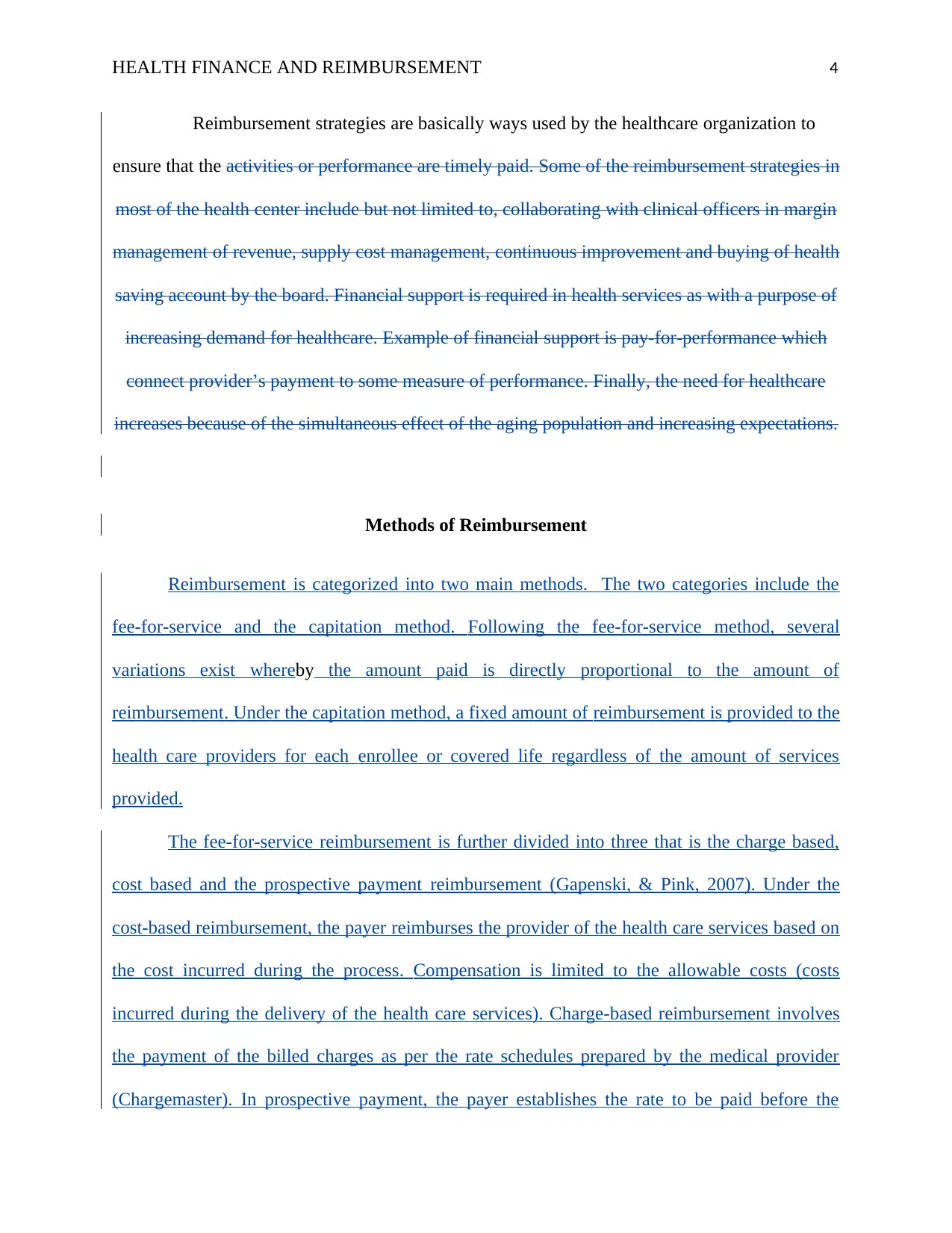
HEALTH FINANCE AND REIMBURSEMENT 4
Reimbursement strategies are basically ways used by the healthcare organization to
ensure that the activities or performance are timely paid. Some of the reimbursement strategies in
most of the health center include but not limited to, collaborating with clinical officers in margin
management of revenue, supply cost management, continuous improvement and buying of health
saving account by the board. Financial support is required in health services as with a purpose of
increasing demand for healthcare. Example of financial support is pay-for-performance which
connect provider’s payment to some measure of performance. Finally, the need for healthcare
increases because of the simultaneous effect of the aging population and increasing expectations.
Methods of Reimbursement
Reimbursement is categorized into two main methods. The two categories include the
fee-for-service and the capitation method. Following the fee-for-service method, several
variations exist whereby the amount paid is directly proportional to the amount of
reimbursement. Under the capitation method, a fixed amount of reimbursement is provided to the
health care providers for each enrollee or covered life regardless of the amount of services
provided.
The fee-for-service reimbursement is further divided into three that is the charge based,
cost based and the prospective payment reimbursement (Gapenski, & Pink, 2007). Under the
cost-based reimbursement, the payer reimburses the provider of the health care services based on
the cost incurred during the process. Compensation is limited to the allowable costs (costs
incurred during the delivery of the health care services). Charge-based reimbursement involves
the payment of the billed charges as per the rate schedules prepared by the medical provider
(Chargemaster). In prospective payment, the payer establishes the rate to be paid before the
Reimbursement strategies are basically ways used by the healthcare organization to
ensure that the activities or performance are timely paid. Some of the reimbursement strategies in
most of the health center include but not limited to, collaborating with clinical officers in margin
management of revenue, supply cost management, continuous improvement and buying of health
saving account by the board. Financial support is required in health services as with a purpose of
increasing demand for healthcare. Example of financial support is pay-for-performance which
connect provider’s payment to some measure of performance. Finally, the need for healthcare
increases because of the simultaneous effect of the aging population and increasing expectations.
Methods of Reimbursement
Reimbursement is categorized into two main methods. The two categories include the
fee-for-service and the capitation method. Following the fee-for-service method, several
variations exist whereby the amount paid is directly proportional to the amount of
reimbursement. Under the capitation method, a fixed amount of reimbursement is provided to the
health care providers for each enrollee or covered life regardless of the amount of services
provided.
The fee-for-service reimbursement is further divided into three that is the charge based,
cost based and the prospective payment reimbursement (Gapenski, & Pink, 2007). Under the
cost-based reimbursement, the payer reimburses the provider of the health care services based on
the cost incurred during the process. Compensation is limited to the allowable costs (costs
incurred during the delivery of the health care services). Charge-based reimbursement involves
the payment of the billed charges as per the rate schedules prepared by the medical provider
(Chargemaster). In prospective payment, the payer establishes the rate to be paid before the
Paraphrase This Document
Need a fresh take? Get an instant paraphrase of this document with our AI Paraphraser
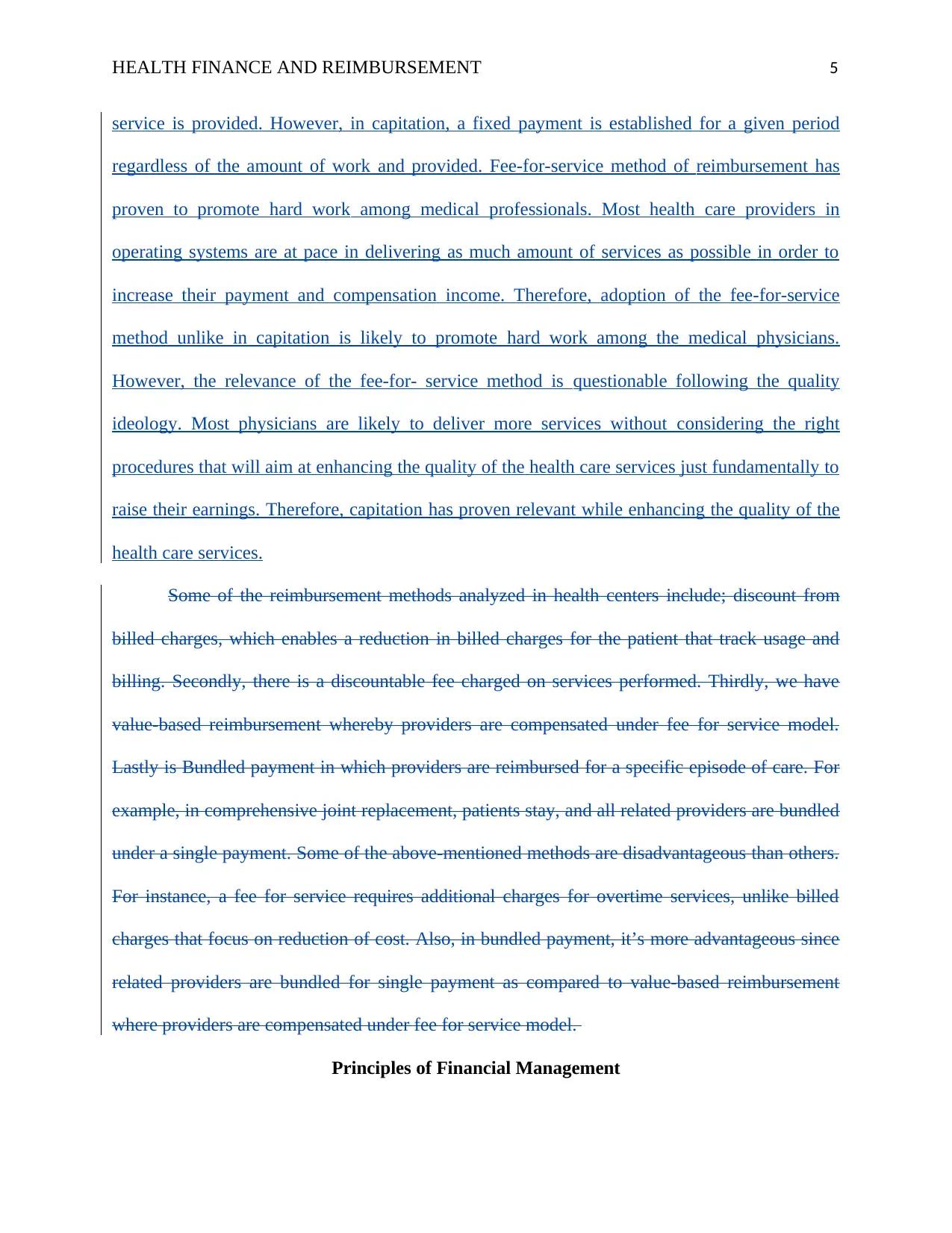
HEALTH FINANCE AND REIMBURSEMENT 5
service is provided. However, in capitation, a fixed payment is established for a given period
regardless of the amount of work and provided. Fee-for-service method of reimbursement has
proven to promote hard work among medical professionals. Most health care providers in
operating systems are at pace in delivering as much amount of services as possible in order to
increase their payment and compensation income. Therefore, adoption of the fee-for-service
method unlike in capitation is likely to promote hard work among the medical physicians.
However, the relevance of the fee-for- service method is questionable following the quality
ideology. Most physicians are likely to deliver more services without considering the right
procedures that will aim at enhancing the quality of the health care services just fundamentally to
raise their earnings. Therefore, capitation has proven relevant while enhancing the quality of the
health care services.
Some of the reimbursement methods analyzed in health centers include; discount from
billed charges, which enables a reduction in billed charges for the patient that track usage and
billing. Secondly, there is a discountable fee charged on services performed. Thirdly, we have
value-based reimbursement whereby providers are compensated under fee for service model.
Lastly is Bundled payment in which providers are reimbursed for a specific episode of care. For
example, in comprehensive joint replacement, patients stay, and all related providers are bundled
under a single payment. Some of the above-mentioned methods are disadvantageous than others.
For instance, a fee for service requires additional charges for overtime services, unlike billed
charges that focus on reduction of cost. Also, in bundled payment, it’s more advantageous since
related providers are bundled for single payment as compared to value-based reimbursement
where providers are compensated under fee for service model.
Principles of Financial Management
service is provided. However, in capitation, a fixed payment is established for a given period
regardless of the amount of work and provided. Fee-for-service method of reimbursement has
proven to promote hard work among medical professionals. Most health care providers in
operating systems are at pace in delivering as much amount of services as possible in order to
increase their payment and compensation income. Therefore, adoption of the fee-for-service
method unlike in capitation is likely to promote hard work among the medical physicians.
However, the relevance of the fee-for- service method is questionable following the quality
ideology. Most physicians are likely to deliver more services without considering the right
procedures that will aim at enhancing the quality of the health care services just fundamentally to
raise their earnings. Therefore, capitation has proven relevant while enhancing the quality of the
health care services.
Some of the reimbursement methods analyzed in health centers include; discount from
billed charges, which enables a reduction in billed charges for the patient that track usage and
billing. Secondly, there is a discountable fee charged on services performed. Thirdly, we have
value-based reimbursement whereby providers are compensated under fee for service model.
Lastly is Bundled payment in which providers are reimbursed for a specific episode of care. For
example, in comprehensive joint replacement, patients stay, and all related providers are bundled
under a single payment. Some of the above-mentioned methods are disadvantageous than others.
For instance, a fee for service requires additional charges for overtime services, unlike billed
charges that focus on reduction of cost. Also, in bundled payment, it’s more advantageous since
related providers are bundled for single payment as compared to value-based reimbursement
where providers are compensated under fee for service model.
Principles of Financial Management
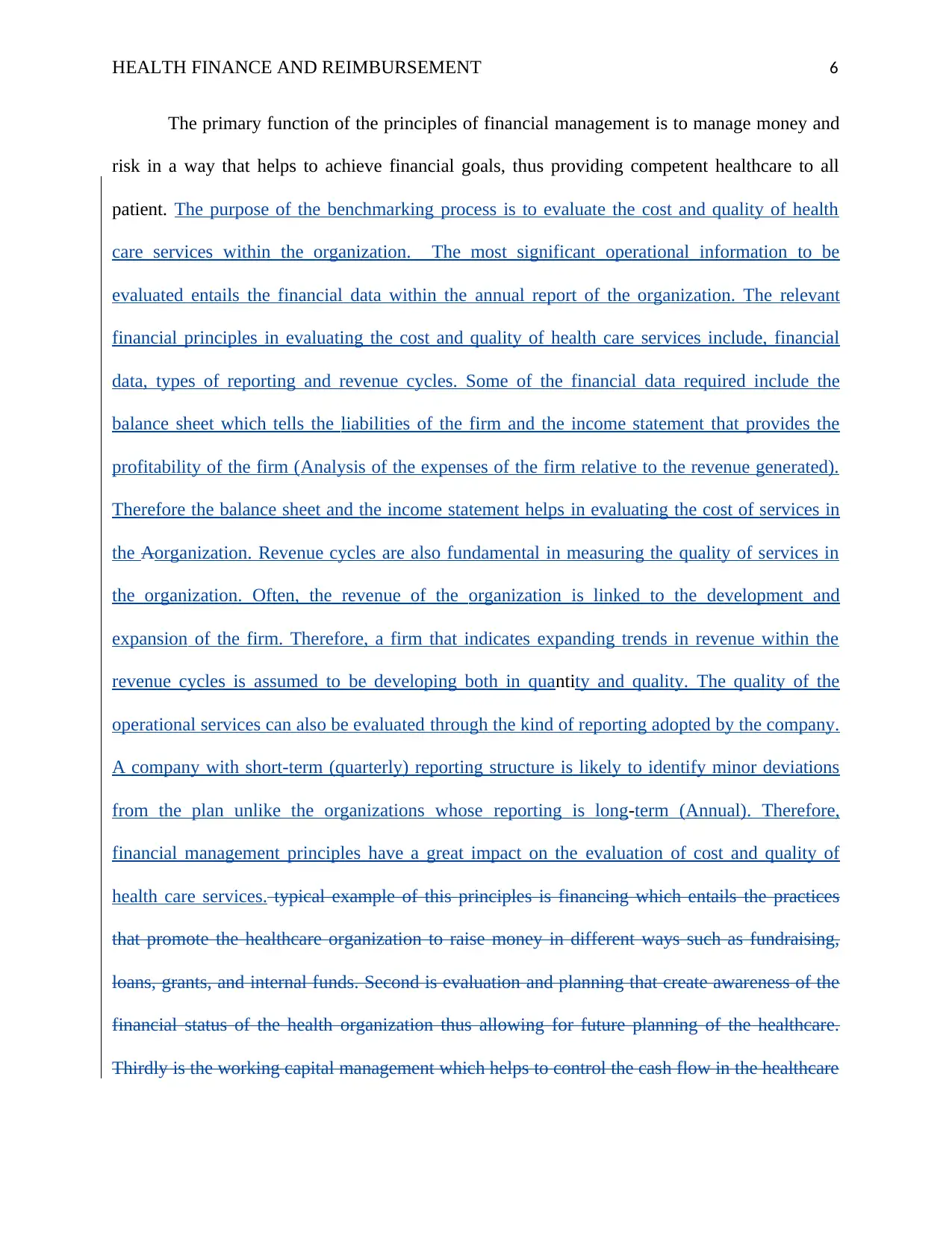
HEALTH FINANCE AND REIMBURSEMENT 6
The primary function of the principles of financial management is to manage money and
risk in a way that helps to achieve financial goals, thus providing competent healthcare to all
patient. The purpose of the benchmarking process is to evaluate the cost and quality of health
care services within the organization. The most significant operational information to be
evaluated entails the financial data within the annual report of the organization. The relevant
financial principles in evaluating the cost and quality of health care services include, financial
data, types of reporting and revenue cycles. Some of the financial data required include the
balance sheet which tells the liabilities of the firm and the income statement that provides the
profitability of the firm (Analysis of the expenses of the firm relative to the revenue generated).
Therefore the balance sheet and the income statement helps in evaluating the cost of services in
the Aorganization. Revenue cycles are also fundamental in measuring the quality of services in
the organization. Often, the revenue of the organization is linked to the development and
expansion of the firm. Therefore, a firm that indicates expanding trends in revenue within the
revenue cycles is assumed to be developing both in quantity and quality. The quality of the
operational services can also be evaluated through the kind of reporting adopted by the company.
A company with short-term (quarterly) reporting structure is likely to identify minor deviations
from the plan unlike the organizations whose reporting is long-term (Annual). Therefore,
financial management principles have a great impact on the evaluation of cost and quality of
health care services. typical example of this principles is financing which entails the practices
that promote the healthcare organization to raise money in different ways such as fundraising,
loans, grants, and internal funds. Second is evaluation and planning that create awareness of the
financial status of the health organization thus allowing for future planning of the healthcare.
Thirdly is the working capital management which helps to control the cash flow in the healthcare
The primary function of the principles of financial management is to manage money and
risk in a way that helps to achieve financial goals, thus providing competent healthcare to all
patient. The purpose of the benchmarking process is to evaluate the cost and quality of health
care services within the organization. The most significant operational information to be
evaluated entails the financial data within the annual report of the organization. The relevant
financial principles in evaluating the cost and quality of health care services include, financial
data, types of reporting and revenue cycles. Some of the financial data required include the
balance sheet which tells the liabilities of the firm and the income statement that provides the
profitability of the firm (Analysis of the expenses of the firm relative to the revenue generated).
Therefore the balance sheet and the income statement helps in evaluating the cost of services in
the Aorganization. Revenue cycles are also fundamental in measuring the quality of services in
the organization. Often, the revenue of the organization is linked to the development and
expansion of the firm. Therefore, a firm that indicates expanding trends in revenue within the
revenue cycles is assumed to be developing both in quantity and quality. The quality of the
operational services can also be evaluated through the kind of reporting adopted by the company.
A company with short-term (quarterly) reporting structure is likely to identify minor deviations
from the plan unlike the organizations whose reporting is long-term (Annual). Therefore,
financial management principles have a great impact on the evaluation of cost and quality of
health care services. typical example of this principles is financing which entails the practices
that promote the healthcare organization to raise money in different ways such as fundraising,
loans, grants, and internal funds. Second is evaluation and planning that create awareness of the
financial status of the health organization thus allowing for future planning of the healthcare.
Thirdly is the working capital management which helps to control the cash flow in the healthcare
⊘ This is a preview!⊘
Do you want full access?
Subscribe today to unlock all pages.

Trusted by 1+ million students worldwide
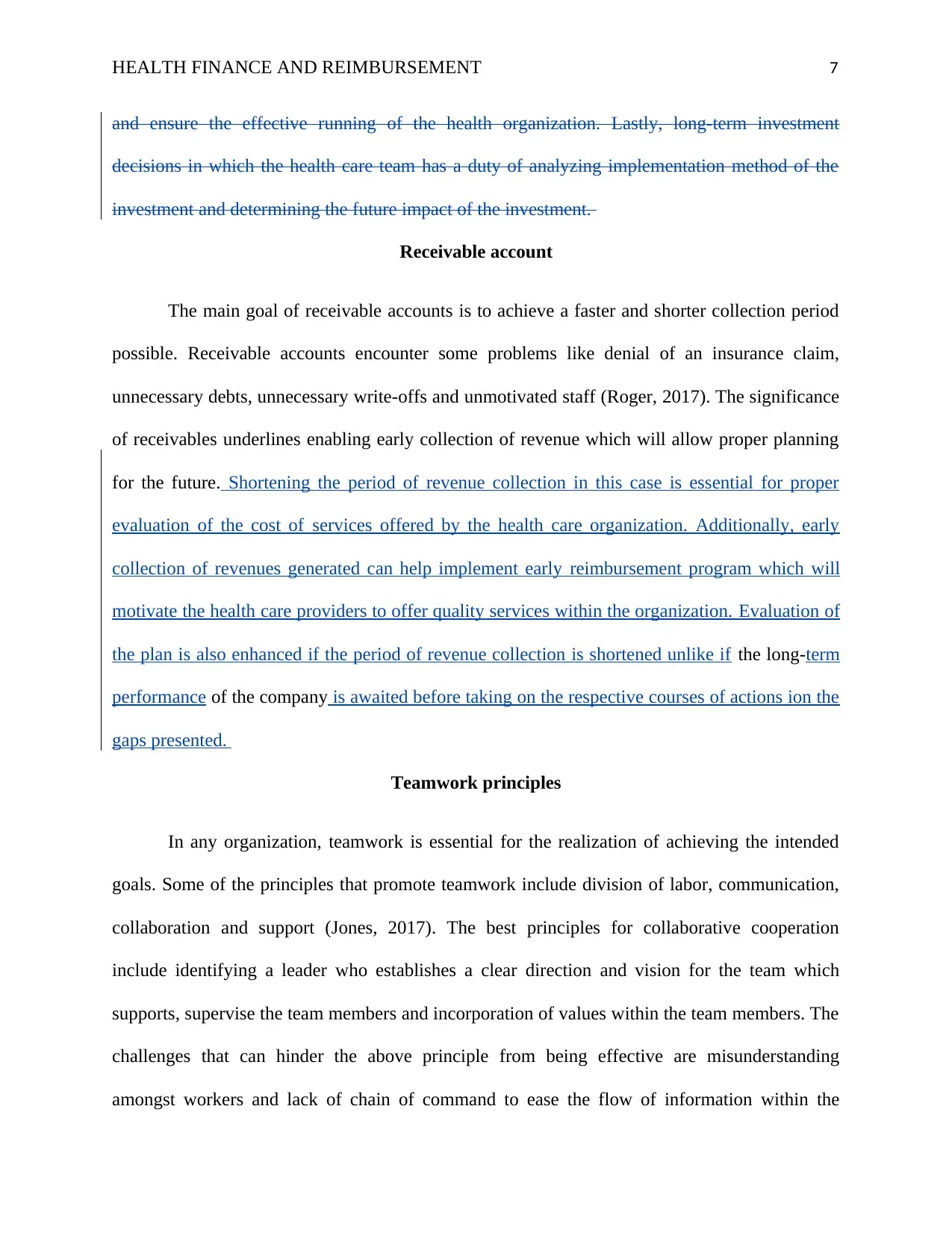
HEALTH FINANCE AND REIMBURSEMENT 7
and ensure the effective running of the health organization. Lastly, long-term investment
decisions in which the health care team has a duty of analyzing implementation method of the
investment and determining the future impact of the investment.
Receivable account
The main goal of receivable accounts is to achieve a faster and shorter collection period
possible. Receivable accounts encounter some problems like denial of an insurance claim,
unnecessary debts, unnecessary write-offs and unmotivated staff (Roger, 2017). The significance
of receivables underlines enabling early collection of revenue which will allow proper planning
for the future. Shortening the period of revenue collection in this case is essential for proper
evaluation of the cost of services offered by the health care organization. Additionally, early
collection of revenues generated can help implement early reimbursement program which will
motivate the health care providers to offer quality services within the organization. Evaluation of
the plan is also enhanced if the period of revenue collection is shortened unlike if the long-term
performance of the company is awaited before taking on the respective courses of actions ion the
gaps presented.
Teamwork principles
In any organization, teamwork is essential for the realization of achieving the intended
goals. Some of the principles that promote teamwork include division of labor, communication,
collaboration and support (Jones, 2017). The best principles for collaborative cooperation
include identifying a leader who establishes a clear direction and vision for the team which
supports, supervise the team members and incorporation of values within the team members. The
challenges that can hinder the above principle from being effective are misunderstanding
amongst workers and lack of chain of command to ease the flow of information within the
and ensure the effective running of the health organization. Lastly, long-term investment
decisions in which the health care team has a duty of analyzing implementation method of the
investment and determining the future impact of the investment.
Receivable account
The main goal of receivable accounts is to achieve a faster and shorter collection period
possible. Receivable accounts encounter some problems like denial of an insurance claim,
unnecessary debts, unnecessary write-offs and unmotivated staff (Roger, 2017). The significance
of receivables underlines enabling early collection of revenue which will allow proper planning
for the future. Shortening the period of revenue collection in this case is essential for proper
evaluation of the cost of services offered by the health care organization. Additionally, early
collection of revenues generated can help implement early reimbursement program which will
motivate the health care providers to offer quality services within the organization. Evaluation of
the plan is also enhanced if the period of revenue collection is shortened unlike if the long-term
performance of the company is awaited before taking on the respective courses of actions ion the
gaps presented.
Teamwork principles
In any organization, teamwork is essential for the realization of achieving the intended
goals. Some of the principles that promote teamwork include division of labor, communication,
collaboration and support (Jones, 2017). The best principles for collaborative cooperation
include identifying a leader who establishes a clear direction and vision for the team which
supports, supervise the team members and incorporation of values within the team members. The
challenges that can hinder the above principle from being effective are misunderstanding
amongst workers and lack of chain of command to ease the flow of information within the
Paraphrase This Document
Need a fresh take? Get an instant paraphrase of this document with our AI Paraphraser
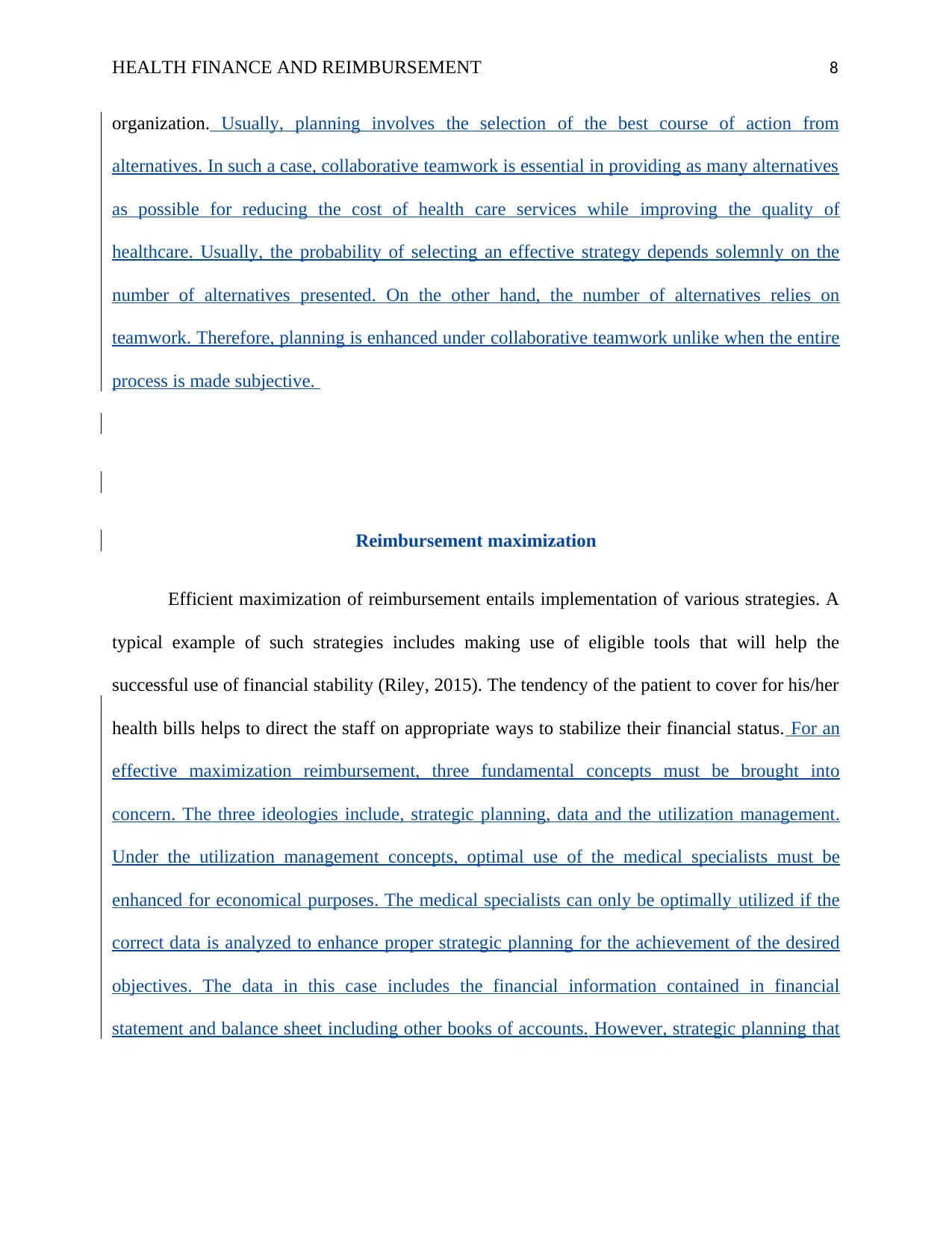
HEALTH FINANCE AND REIMBURSEMENT 8
organization. Usually, planning involves the selection of the best course of action from
alternatives. In such a case, collaborative teamwork is essential in providing as many alternatives
as possible for reducing the cost of health care services while improving the quality of
healthcare. Usually, the probability of selecting an effective strategy depends solemnly on the
number of alternatives presented. On the other hand, the number of alternatives relies on
teamwork. Therefore, planning is enhanced under collaborative teamwork unlike when the entire
process is made subjective.
Reimbursement maximization
Efficient maximization of reimbursement entails implementation of various strategies. A
typical example of such strategies includes making use of eligible tools that will help the
successful use of financial stability (Riley, 2015). The tendency of the patient to cover for his/her
health bills helps to direct the staff on appropriate ways to stabilize their financial status. For an
effective maximization reimbursement, three fundamental concepts must be brought into
concern. The three ideologies include, strategic planning, data and the utilization management.
Under the utilization management concepts, optimal use of the medical specialists must be
enhanced for economical purposes. The medical specialists can only be optimally utilized if the
correct data is analyzed to enhance proper strategic planning for the achievement of the desired
objectives. The data in this case includes the financial information contained in financial
statement and balance sheet including other books of accounts. However, strategic planning that
organization. Usually, planning involves the selection of the best course of action from
alternatives. In such a case, collaborative teamwork is essential in providing as many alternatives
as possible for reducing the cost of health care services while improving the quality of
healthcare. Usually, the probability of selecting an effective strategy depends solemnly on the
number of alternatives presented. On the other hand, the number of alternatives relies on
teamwork. Therefore, planning is enhanced under collaborative teamwork unlike when the entire
process is made subjective.
Reimbursement maximization
Efficient maximization of reimbursement entails implementation of various strategies. A
typical example of such strategies includes making use of eligible tools that will help the
successful use of financial stability (Riley, 2015). The tendency of the patient to cover for his/her
health bills helps to direct the staff on appropriate ways to stabilize their financial status. For an
effective maximization reimbursement, three fundamental concepts must be brought into
concern. The three ideologies include, strategic planning, data and the utilization management.
Under the utilization management concepts, optimal use of the medical specialists must be
enhanced for economical purposes. The medical specialists can only be optimally utilized if the
correct data is analyzed to enhance proper strategic planning for the achievement of the desired
objectives. The data in this case includes the financial information contained in financial
statement and balance sheet including other books of accounts. However, strategic planning that
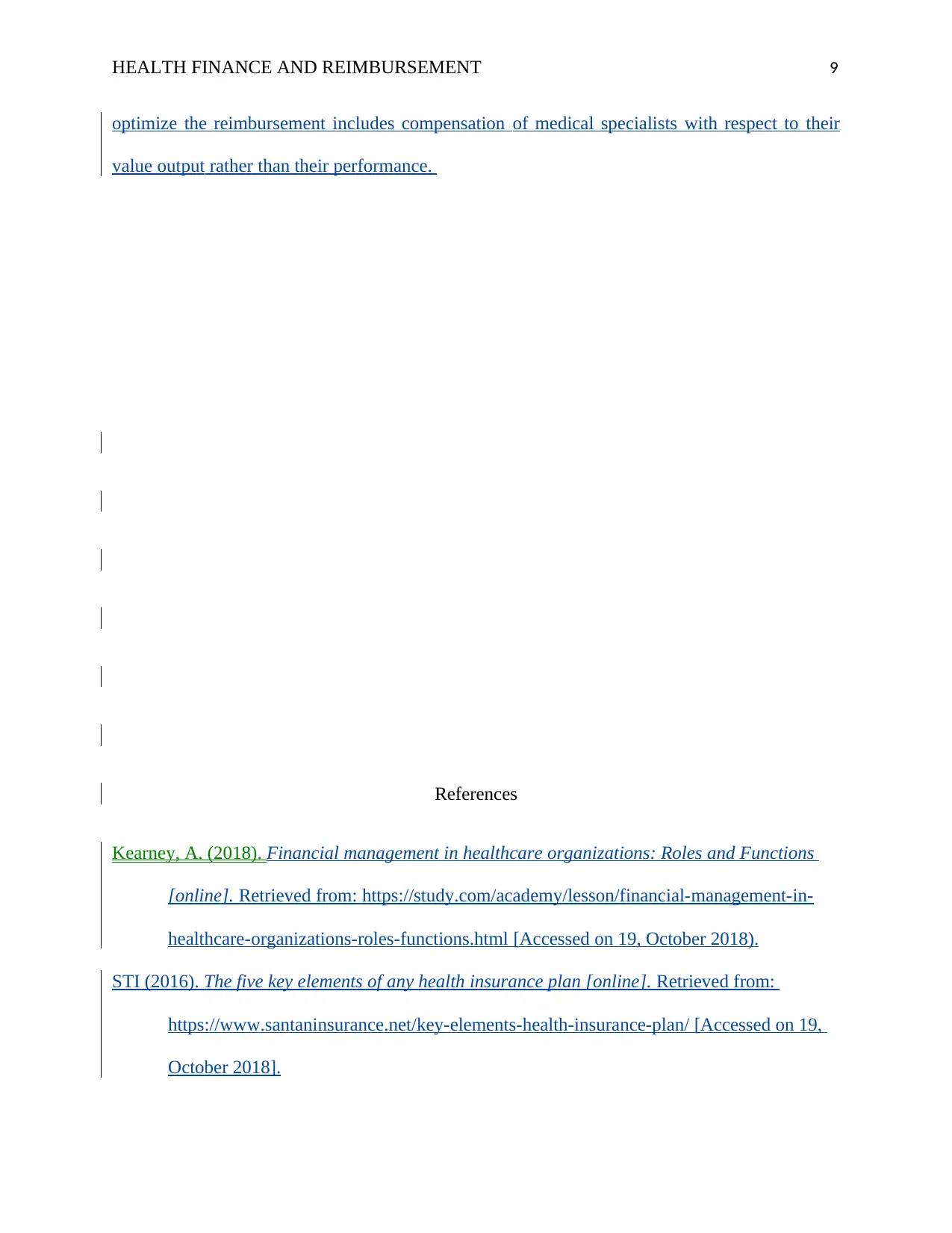
HEALTH FINANCE AND REIMBURSEMENT 9
optimize the reimbursement includes compensation of medical specialists with respect to their
value output rather than their performance.
References
Kearney, A. (2018). Financial management in healthcare organizations: Roles and Functions
[online]. Retrieved from: https://study.com/academy/lesson/financial-management-in-
healthcare-organizations-roles-functions.html [Accessed on 19, October 2018).
STI (2016). The five key elements of any health insurance plan [online]. Retrieved from:
https://www.santaninsurance.net/key-elements-health-insurance-plan/ [Accessed on 19,
October 2018].
optimize the reimbursement includes compensation of medical specialists with respect to their
value output rather than their performance.
References
Kearney, A. (2018). Financial management in healthcare organizations: Roles and Functions
[online]. Retrieved from: https://study.com/academy/lesson/financial-management-in-
healthcare-organizations-roles-functions.html [Accessed on 19, October 2018).
STI (2016). The five key elements of any health insurance plan [online]. Retrieved from:
https://www.santaninsurance.net/key-elements-health-insurance-plan/ [Accessed on 19,
October 2018].
⊘ This is a preview!⊘
Do you want full access?
Subscribe today to unlock all pages.

Trusted by 1+ million students worldwide
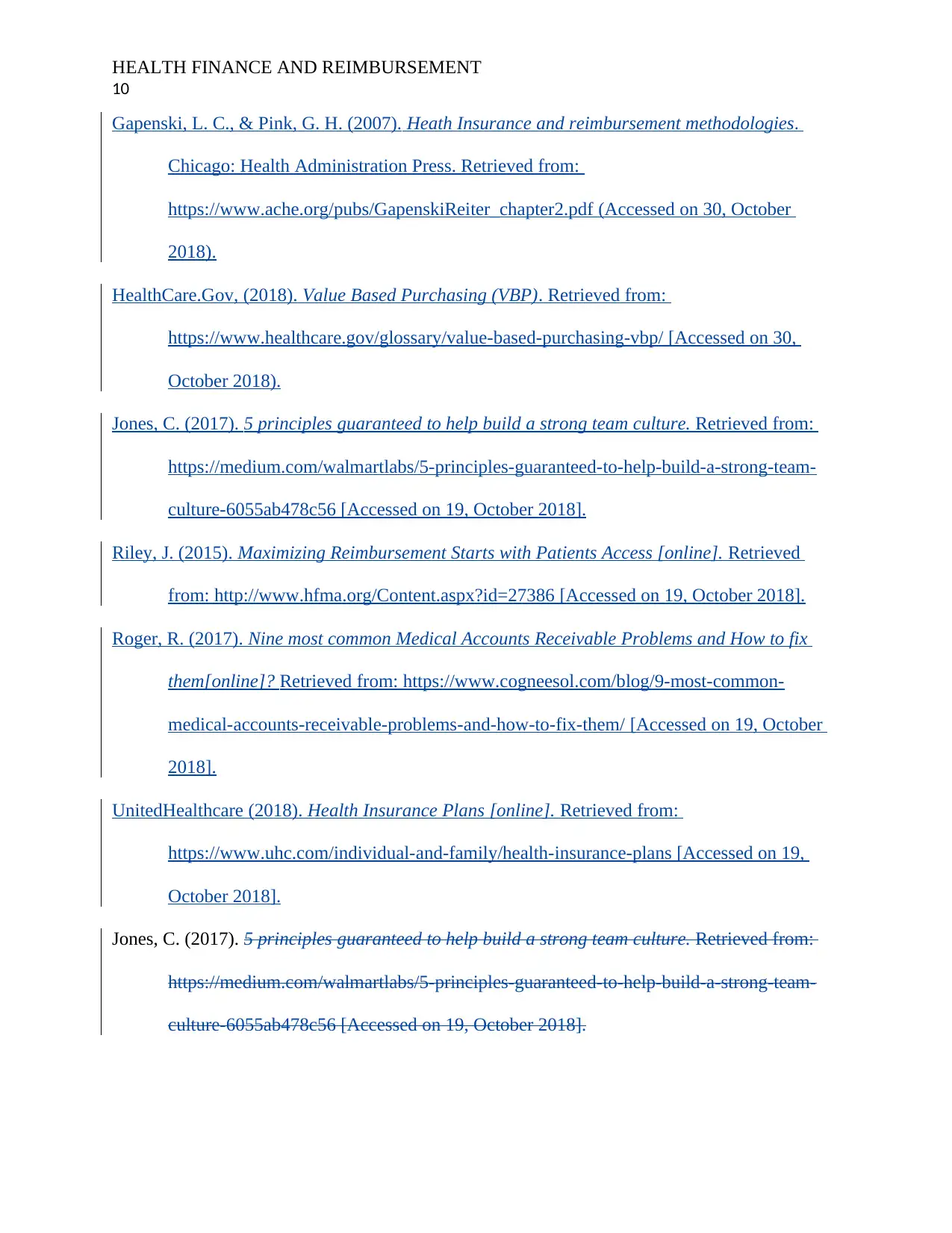
HEALTH FINANCE AND REIMBURSEMENT
10
Gapenski, L. C., & Pink, G. H. (2007). Heath Insurance and reimbursement methodologies.
Chicago: Health Administration Press. Retrieved from:
https://www.ache.org/pubs/GapenskiReiter_chapter2.pdf (Accessed on 30, October
2018).
HealthCare.Gov, (2018). Value Based Purchasing (VBP). Retrieved from:
https://www.healthcare.gov/glossary/value-based-purchasing-vbp/ [Accessed on 30,
October 2018).
Jones, C. (2017). 5 principles guaranteed to help build a strong team culture. Retrieved from:
https://medium.com/walmartlabs/5-principles-guaranteed-to-help-build-a-strong-team-
culture-6055ab478c56 [Accessed on 19, October 2018].
Riley, J. (2015). Maximizing Reimbursement Starts with Patients Access [online]. Retrieved
from: http://www.hfma.org/Content.aspx?id=27386 [Accessed on 19, October 2018].
Roger, R. (2017). Nine most common Medical Accounts Receivable Problems and How to fix
them[online]? Retrieved from: https://www.cogneesol.com/blog/9-most-common-
medical-accounts-receivable-problems-and-how-to-fix-them/ [Accessed on 19, October
2018].
UnitedHealthcare (2018). Health Insurance Plans [online]. Retrieved from:
https://www.uhc.com/individual-and-family/health-insurance-plans [Accessed on 19,
October 2018].
Jones, C. (2017). 5 principles guaranteed to help build a strong team culture. Retrieved from:
https://medium.com/walmartlabs/5-principles-guaranteed-to-help-build-a-strong-team-
culture-6055ab478c56 [Accessed on 19, October 2018].
10
Gapenski, L. C., & Pink, G. H. (2007). Heath Insurance and reimbursement methodologies.
Chicago: Health Administration Press. Retrieved from:
https://www.ache.org/pubs/GapenskiReiter_chapter2.pdf (Accessed on 30, October
2018).
HealthCare.Gov, (2018). Value Based Purchasing (VBP). Retrieved from:
https://www.healthcare.gov/glossary/value-based-purchasing-vbp/ [Accessed on 30,
October 2018).
Jones, C. (2017). 5 principles guaranteed to help build a strong team culture. Retrieved from:
https://medium.com/walmartlabs/5-principles-guaranteed-to-help-build-a-strong-team-
culture-6055ab478c56 [Accessed on 19, October 2018].
Riley, J. (2015). Maximizing Reimbursement Starts with Patients Access [online]. Retrieved
from: http://www.hfma.org/Content.aspx?id=27386 [Accessed on 19, October 2018].
Roger, R. (2017). Nine most common Medical Accounts Receivable Problems and How to fix
them[online]? Retrieved from: https://www.cogneesol.com/blog/9-most-common-
medical-accounts-receivable-problems-and-how-to-fix-them/ [Accessed on 19, October
2018].
UnitedHealthcare (2018). Health Insurance Plans [online]. Retrieved from:
https://www.uhc.com/individual-and-family/health-insurance-plans [Accessed on 19,
October 2018].
Jones, C. (2017). 5 principles guaranteed to help build a strong team culture. Retrieved from:
https://medium.com/walmartlabs/5-principles-guaranteed-to-help-build-a-strong-team-
culture-6055ab478c56 [Accessed on 19, October 2018].
Paraphrase This Document
Need a fresh take? Get an instant paraphrase of this document with our AI Paraphraser
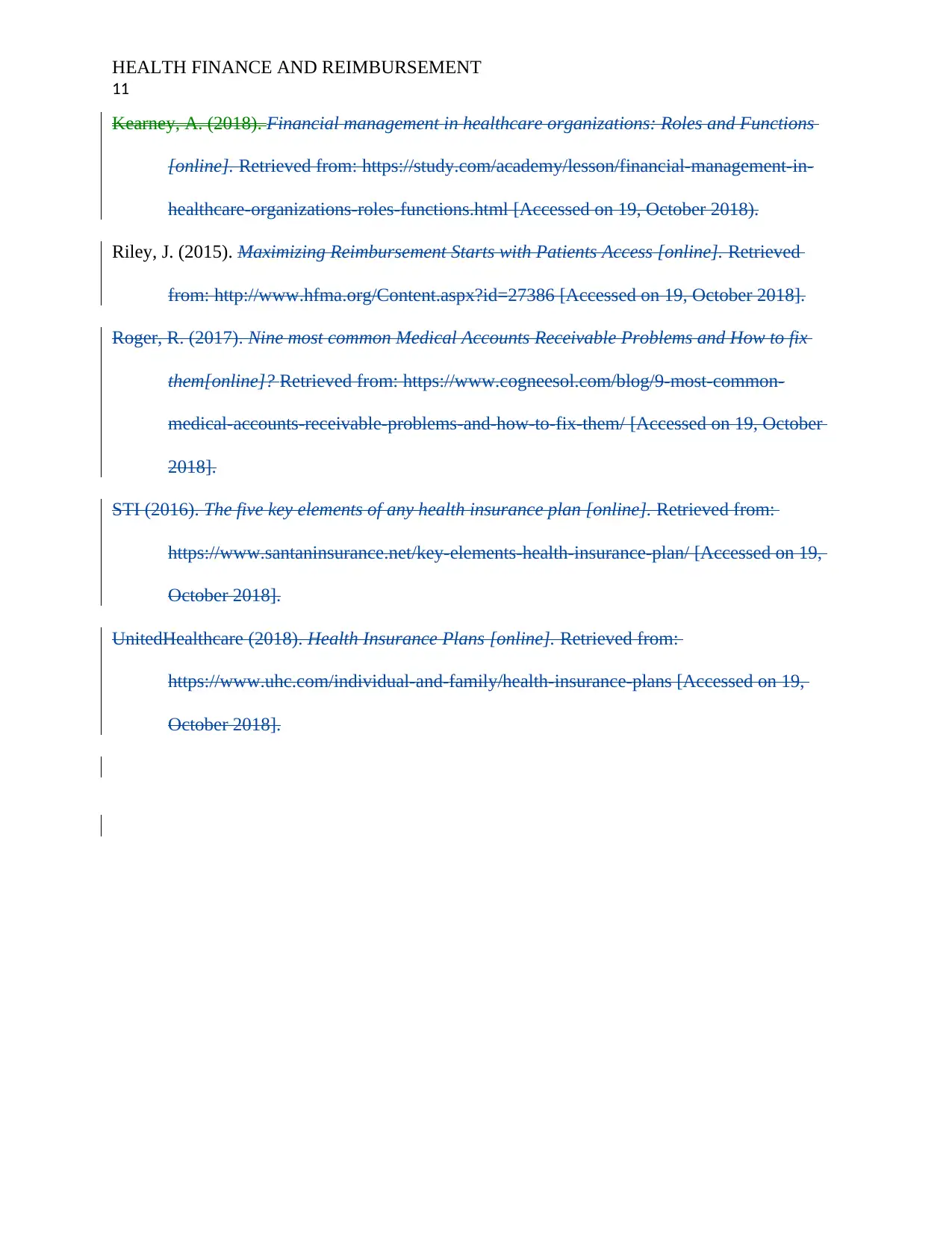
HEALTH FINANCE AND REIMBURSEMENT
11
Kearney, A. (2018). Financial management in healthcare organizations: Roles and Functions
[online]. Retrieved from: https://study.com/academy/lesson/financial-management-in-
healthcare-organizations-roles-functions.html [Accessed on 19, October 2018).
Riley, J. (2015). Maximizing Reimbursement Starts with Patients Access [online]. Retrieved
from: http://www.hfma.org/Content.aspx?id=27386 [Accessed on 19, October 2018].
Roger, R. (2017). Nine most common Medical Accounts Receivable Problems and How to fix
them[online]? Retrieved from: https://www.cogneesol.com/blog/9-most-common-
medical-accounts-receivable-problems-and-how-to-fix-them/ [Accessed on 19, October
2018].
STI (2016). The five key elements of any health insurance plan [online]. Retrieved from:
https://www.santaninsurance.net/key-elements-health-insurance-plan/ [Accessed on 19,
October 2018].
UnitedHealthcare (2018). Health Insurance Plans [online]. Retrieved from:
https://www.uhc.com/individual-and-family/health-insurance-plans [Accessed on 19,
October 2018].
11
Kearney, A. (2018). Financial management in healthcare organizations: Roles and Functions
[online]. Retrieved from: https://study.com/academy/lesson/financial-management-in-
healthcare-organizations-roles-functions.html [Accessed on 19, October 2018).
Riley, J. (2015). Maximizing Reimbursement Starts with Patients Access [online]. Retrieved
from: http://www.hfma.org/Content.aspx?id=27386 [Accessed on 19, October 2018].
Roger, R. (2017). Nine most common Medical Accounts Receivable Problems and How to fix
them[online]? Retrieved from: https://www.cogneesol.com/blog/9-most-common-
medical-accounts-receivable-problems-and-how-to-fix-them/ [Accessed on 19, October
2018].
STI (2016). The five key elements of any health insurance plan [online]. Retrieved from:
https://www.santaninsurance.net/key-elements-health-insurance-plan/ [Accessed on 19,
October 2018].
UnitedHealthcare (2018). Health Insurance Plans [online]. Retrieved from:
https://www.uhc.com/individual-and-family/health-insurance-plans [Accessed on 19,
October 2018].
1 out of 11
Related Documents
Your All-in-One AI-Powered Toolkit for Academic Success.
+13062052269
info@desklib.com
Available 24*7 on WhatsApp / Email
![[object Object]](/_next/static/media/star-bottom.7253800d.svg)
Unlock your academic potential
Copyright © 2020–2025 A2Z Services. All Rights Reserved. Developed and managed by ZUCOL.





